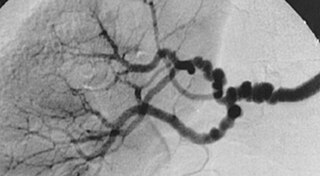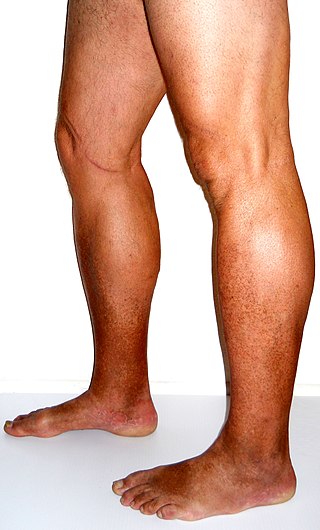Related Research Articles

Hypertension, also known as high blood pressure, is a long-term medical condition in which the blood pressure in the arteries is persistently elevated. High blood pressure usually does not cause symptoms. It is, however, a major risk factor for stroke, coronary artery disease, heart failure, atrial fibrillation, peripheral arterial disease, vision loss, chronic kidney disease, and dementia. Hypertension is a major cause of premature death worldwide.

A mouth ulcer (aphtha) is an ulcer that occurs on the mucous membrane of the oral cavity. Mouth ulcers are very common, occurring in association with many diseases and by many different mechanisms, but usually there is no serious underlying cause. Rarely, a mouth ulcer that does not heal may be a sign of oral cancer. These ulcers may form individually or multiple ulcers may appear at once. Once formed, an ulcer may be maintained by inflammation and/or secondary infection.

Chancroid is a bacterial sexually transmitted infection characterized by painful sores on the genitalia. Chancroid is known to spread from one individual to another solely through sexual contact. However, there have been reports of accidental infection through the hand.

A hypertensive emergency is very high blood pressure with potentially life-threatening symptoms and signs of acute damage to one or more organ systems. It is different from a hypertensive urgency by this additional evidence for impending irreversible hypertension-mediated organ damage (HMOD). Blood pressure is often above 200/120 mmHg, however there are no universally accepted cutoff values.
Severely elevated blood pressure is referred to as a hypertensive crisis, as blood pressure at this level confers a high risk of complications. People with blood pressures in this range may have no symptoms, but are more likely to report headaches and dizziness than the general population. Other symptoms accompanying a hypertensive crisis may include visual deterioration due to retinopathy, breathlessness due to heart failure, or a general feeling of malaise due to kidney failure. Most people with a hypertensive crisis are known to have elevated blood pressure, but additional triggers may have led to a sudden rise.

Pyoderma gangrenosum is a rare, inflammatory skin disease where painful pustules or nodules become ulcers that progressively grow. Pyoderma gangrenosum is not infectious.

Venous ulcer is defined by the American Venous Forum as "a full-thickness defect of skin, most frequently in the ankle region, that fails to heal spontaneously and is sustained by chronic venous disease, based on venous duplex ultrasound testing." Venous ulcers are wounds that are thought to occur due to improper functioning of venous valves, usually of the legs. They are an important cause of chronic wounds, affecting 1% of the population. Venous ulcers develop mostly along the medial distal leg, and can be painful with negative effects on quality of life.

Fibromuscular dysplasia (FMD) is a non-atherosclerotic, non-inflammatory disease of the blood vessels that causes abnormal growth within the wall of an artery. FMD has been found in nearly every arterial bed in the body, although the most commonly affected are the renal and carotid arteries.

Vascular disease is a class of diseases of the vessels of the circulatory system in the body, including blood vessels – the arteries and veins, and the lymphatic vessels. Vascular disease is a subgroup of cardiovascular disease. Disorders in this vast network of blood and lymph vessels can cause a range of health problems that can sometimes become severe, and fatal. Coronary heart disease for example, is the leading cause of death for men and women in the United States.

Calciphylaxis, also known as calcific uremic arteriolopathy (CUA) or “Grey Scale”, is a rare syndrome characterized by painful skin lesions. The pathogenesis of calciphylaxis is unclear but believed to involve calcification of the small blood vessels located within the fatty tissue and deeper layers of the skin, blood clots, and eventual death of skin cells due to lack of blood flow. It is seen mostly in people with end-stage kidney disease but can occur in the earlier stages of chronic kidney disease and rarely in people with normally functioning kidneys. Calciphylaxis is a rare but serious disease, believed to affect 1-4% of all dialysis patients. It results in chronic non-healing wounds and indicates poor prognosis, with typical life expectancy of less than one year.
Hypertensive encephalopathy (HE) is general brain dysfunction due to significantly high blood pressure. Symptoms may include headache, vomiting, trouble with balance, and confusion. Onset is generally sudden. Complications can include seizures, posterior reversible encephalopathy syndrome, and bleeding in the back of the eye.
In medicine, systolic hypertension is defined as an elevated systolic blood pressure (SBP). If the systolic blood pressure is elevated (>140) with a normal (<90) diastolic blood pressure (DBP), it is called isolated systolic hypertension. Eighty percent of people with systolic hypertension are over the age of 65 years old.

Chronic venous insufficiency (CVI) is a medical condition in which blood pools in the veins, straining the walls of the vein. The most common cause of CVI is superficial venous reflux which is a treatable condition. As functional venous valves are required to provide for efficient blood return from the lower extremities, this condition typically affects the legs. If the impaired vein function causes significant symptoms, such as swelling and ulcer formation, it is referred to as chronic venous disease. It is sometimes called chronic peripheral venous insufficiency and should not be confused with post-thrombotic syndrome in which the deep veins have been damaged by previous deep vein thrombosis.

Tropical ulcer, more commonly known as jungle rot, is a chronic ulcerative skin lesion thought to be caused by polymicrobial infection with a variety of microorganisms, including mycobacteria. It is common in tropical climates.

Complications of hypertension are clinical outcomes that result from persistent elevation of blood pressure. Hypertension is a risk factor for all clinical manifestations of atherosclerosis since it is a risk factor for atherosclerosis itself. It is an independent predisposing factor for heart failure, coronary artery disease, stroke, kidney disease, and peripheral arterial disease. It is the most important risk factor for cardiovascular morbidity and mortality, in industrialized countries.

Behçet's disease (BD) is a type of inflammatory disorder which affects multiple parts of the body. The most common symptoms include painful sores on the mucous membranes of the mouth and other parts of the body, inflammation of parts of the eye, and arthritis. The sores can last from a few days, up to a week or more. Less commonly there may be inflammation of the brain or spinal cord, blood clots, aneurysms, or blindness. Often, the symptoms come and go.
Martorell is a town near Barcelona, Catalonia, Spain.
Orthostatic hypertension is a medical condition consisting of a sudden and abrupt increase in blood pressure (BP) when a person stands up. Orthostatic hypertension is diagnosed by a rise in systolic BP of 20 mmHg or more when standing. Orthostatic diastolic hypertension is a condition in which the diastolic BP raises to 98 mmHg or over in response to standing, but this definition currently lacks clear medical consensus, so is subject to change. Orthostatic hypertension involving the systolic BP is known as systolic orthostatic hypertension.
Chronic wound pain is a condition described as unremitting, disabling, and recalcitrant pain experienced by individuals with various types of chronic wounds. Chronic wounds such as venous leg ulcers, arterial ulcers, diabetic foot ulcers, pressure ulcers, and malignant wounds can have an enormous impact on an individual’s quality of life with pain being one of the most distressing symptoms.
Hypertensive disease of pregnancy, also known as maternal hypertensive disorder, is a group of high blood pressure disorders that include preeclampsia, preeclampsia superimposed on chronic hypertension, gestational hypertension, and chronic hypertension.
References
- 1 2 Senet P, Vicaut E, Beneton N, Debure C, Lok C, Chosidow O (August 2011). "Topical Treatment of Hypertensive Leg Ulcers With Platelet-Derived Growth Factor-BB A Randomized Controlled Trial". Archives of Dermatology. 147 (8): 926–930. doi: 10.1001/archdermatol.2011.84 . PMID 21482863.
- ↑ El Anany G, Nahui N, Nada H, Rabeaa M, Sany I, Nada A, El-Gheit AA, El Ghanam O (2020). "Martorell's hypertensive ischemic leg ulcer: a case report". Journal of the Egyptian Women's Dermatologic Society. 17 (1): 62–65. doi: 10.4103/JEWD.JEWD_47_19 .
- ↑ Palou, J (December 1955). "Lumbar Sympathectomy in the Treatment of Hypertensive Isehemic Ulcers of the Leg (Martorell's Syndrome)". Circulation. 12 (2): 239–241. doi: 10.1161/01.cir.12.2.239 . PMID 13240805.
- ↑ "Fernando Martorell Otzet (1906-1984)". Angiologia. 36 (6): 267. 1984. PMID 6393826.
- ↑ Shutler, S. D.; Baragwanath, P.; Harding, K. G. (1995). "Martorell's ulcer". Postgraduate Medical Journal. 71 (842): 717–9. doi:10.1136/pgmj.71.842.717. PMC 2398295 . PMID 8552533.
- ↑ Alonso, T (1954). "Diastolic arterial hypertension and ulcer of the leg: Martorell's syndrome". Lancet. 266 (6821): 1059. doi:10.1016/S0140-6736(54)91622-0. PMID 13164326.
- ↑ Davison, Steven; Lee, Edward; Newton, Edward D (2003). "Martorell's Ulcer Revisited". Wounds. 15 (6). Retrieved 29 April 2013.
- ↑ De Andrés, José; Villanueva, Vicente L.; Mazzinari, Guido; Fabregat, Gustavo; Asensio, Juan Marcos; Monsalve, Vicente (2011). "Use of a spinal Cord Stimulator for Treatment of Martorell Hypertensive Ulcer". Regional Anesthesia and Pain Medicine. 36 (1): 83–6. doi:10.1097/AAP.0b013e31820308b2. PMID 21455092. S2CID 40900081.